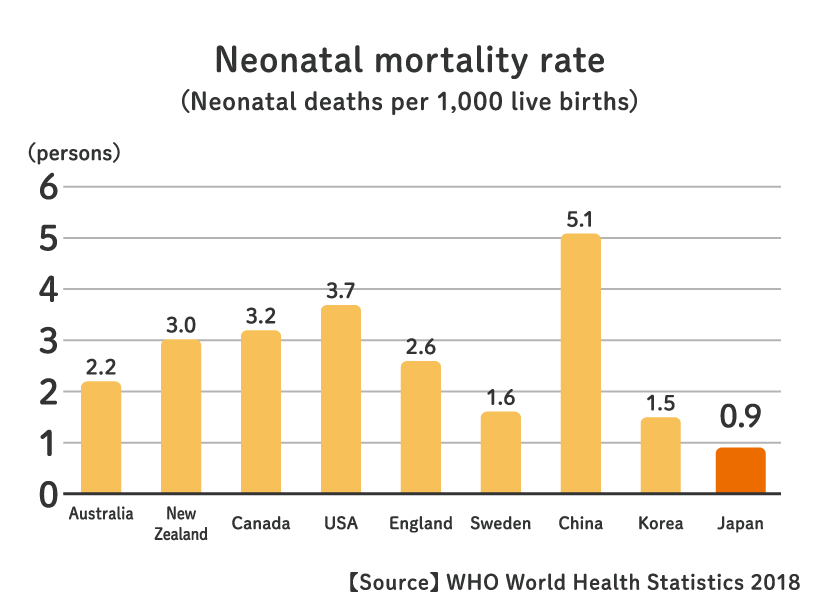The NICU provides management of artificial respirators, fluid management, etc.
utilizing respiratory and heart rate monitors that are constantly attached to infants.
 About NICU/GCU
About NICU/GCU
Here, we will explain about neonatal care in Japan and differences between NICU and GCU, as well as introducing infant incubators and other medical devices used in the NICU/GCU.
Neonatal Care in Japan
Neonatal care is advancing day by day. In recent years, Japan's neonatal mortality rate (babies under 28 days old) is 0.9 per 1,000 live births, which means the highest-level care in the world.
In particular, the survival rate of preterm babies with short gestational ages in which his/her life would have been lost in the past, has improved dramatically in the last 10 years, and becoming top-class when compared to developed countries such as Australia, New Zealand, Canada, USA, UK, and Sweden, and it can be said that Japan provides the most mother-child-friendly medical care in the world (see figure).
Today, the goal of neonatal care in Japan is not just to save lives, but is to provide future-oriented medical care that supports children who have grown to adapt to the future society, that is, "Survival without Subsequent Complications (Intact Survival)".

What is NICU/GCU?
"Birth" is one of the most precious moments in life, but is also a high-risk moment for both the mother and child. In this process, the baby may have respiratory or circulatory complications and may require whole body care. The risk is even higher for premature delivery. The NICU (Neonatal Intensive Care Unit) is a place where the medical staff will monitor 24 hours a day, the heart rate, blood pressure, oxygen saturation (oxygen status in the blood), etc. of such babies, and will provide advanced treatment such as respiratory and fluid management.
On the other hand, the GCU (Growing Care Unit) is a place where babies whose condition has stabilized in the NICU continue to receive treatment. Depending on the baby's weight and condition, he/she may be hospitalized in the GCU from the beginning. At the GCU, our nursing staff will cooperate with various professional staffs to provide childcare environment and childcare guidance towards discharge, so that families can proceed with childcare at home.

Difference between NICU and GCU NEW!
| NICU | GCU | |
|---|---|---|
| What kind of babies are admitted to this care unit? |
Babies admitted to an NICU are those needing support for breathing, circulation, nourishment, and other problems after birth due to a variety of factors before and after birth. | Babies admitted to a GCU are those who have completed treatments in the NICU and whose respiratory, circulatory, and nutritional conditions have stabilized. |
| What does this care unit specialize in? |
This is an intensive care unit specializing in care of neonates. Physicians and nurses are on duty around the clock to respond to sudden changes in the conditions of preterm infants. |
This is a place where babies who have completed acute treatment in an NICU are being prepared to be discharged from the hospital. |
| What does this care unit do? |

|
Nurses, pharmacists, and clinical engineers teach parents how to provide appropriate care for babies at home after being discharged, such as breastfeeding, changing diapers, bathing, administration of oral medicines, management of a home artificial respirator, replacement of tracheostomy tubes, and injection of milk. 
|
Role of the Infant Incubator
When providing whole body care for babies born prematurely and small, it is very important to keep the environment in which the baby spends at an appropriate temperature and humidity. This is because preterm infants have immature skin and cannot maintain proper temperature without support, in which substantial amount of moisture is lost from the skin and may result in hypothermia or dehydration. Hypothermia and dehydration are not as simple as only giving cold limbs, but may lead to the deterioration of his/her general condition, including respiration and circulation. Therefore, the incubator replaces the mother's womb and protects the baby's overall condition. It is no exaggeration to say that the development of neonatal care in Japan is supported by the progress of this incubator.

Role of Other Medical Devices
In addition to the Infant incubator, many other medical devices protect the baby in the NICU.
Respiratory / ECG monitor / Pulse oximeter
This device constantly displays the baby's heart rate, respiratory rate, respiratory waveform, and oxygen saturation in the blood on the monitor screen. The displayed numbers will help check the baby's overall condition in real time.
Respiratory apparatus
This device is used for babies with immature respiratory function. This will support breathing by inserting tubes into the windpipe (trachea) or wearing a nasal mask.
Phototherapy equipment
This device is used for babies with symptoms of jaundice and requires treatment. The baby is treated by absorbing the light.
Infusion pump / Syringe pump
This is an essential medical device for administering water, electrolytes, nutritional supplements, and medicine to babies. It helps precise administration at the rate and amount that suits each baby.
